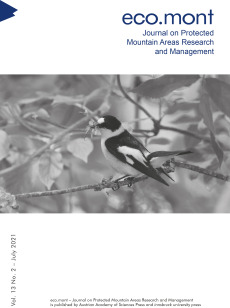eco.mont – Journal on Protected Mountain Areas Research and Management, Vol. 13 / No. 2
Herausgegeben von Martin Coy, Herausgegeben von Günter Köck, Herausgegeben von Valerie Braun
Reihe: eco.mont“eco.mont – Journal of Protected Mountain Areas Research and Management” was founded as a joint initiative of the Alpine Network of Protected Areas (ALPARC), the International Scientific Committee on Research in the Alps (ISCAR), the Austrian Academy of Sciences and the University of Innsbruck. “eco.mont” offers a platform specifically for scientists and practitioners working in and on protected mountain areas in Europe and overseas. Target audiences of the journal are scientists from all related disciplines, managers of protected areas and an interested public including practitioners, visitors, teachers, etc.“eco.mont” is available by open access under CC BY-NC-ND-Licence from the Austrian Academy Press and in a printed version from Innsbruck University Press.
Since Covid-19 forced many of us to stay at home and work from there, many meetings were held online or even cancelled altogether. Virtual meetings, advanced as they may be, have not been able to really replace physical meetings. Thus, the editorial board of eco.mont decided to introduce themselves to our readers in the editorial of this issue and to share their enthusiasm for the idea behind the journal. The scientific articles in this issue analyse the discourses of two movements opposing national park projects in Switzerland, illustrate the resilience of protected mountain areas in Austria and Nepal, and explore the motives for visiting national parks in Serbia. The reports in this issue showcase a variety of different topics: the sustainable forest development in the Styrian Eisenwurzen Nature and Geopark which is embedded between the Dürrenstein wilderness area, the Kalkalpen National Park and the Gesäuse National Park; the development of partnerships between nature conservation and local companies in the Styrian Eisenwurzen Nature Park and Gesäuse National Park; the description of a participatory process to work on a regional development concept for the UNESCO Biosphere Reserve Großes Walsertal; the opportunities and challenges for transdisciplinary research in flood risk management in Austria; the field project in the Nature 2000 area Spessart which reached the final stage of the 2020 EU-Natura 2000 award; the different ontologies and opposing views on mountains which led to a temporarily protected area in the Peruvian Andes; the current status and future prospects of the Lhalu wetland in Lhasa city in Tibet; the description of an Alpine session within the Mountain Biodiversity Day and the introduction of a project which values and benefits from the ecological infrastructure in Swiss parks. This edition again showcases the many issues that affect protected mountain areas.

